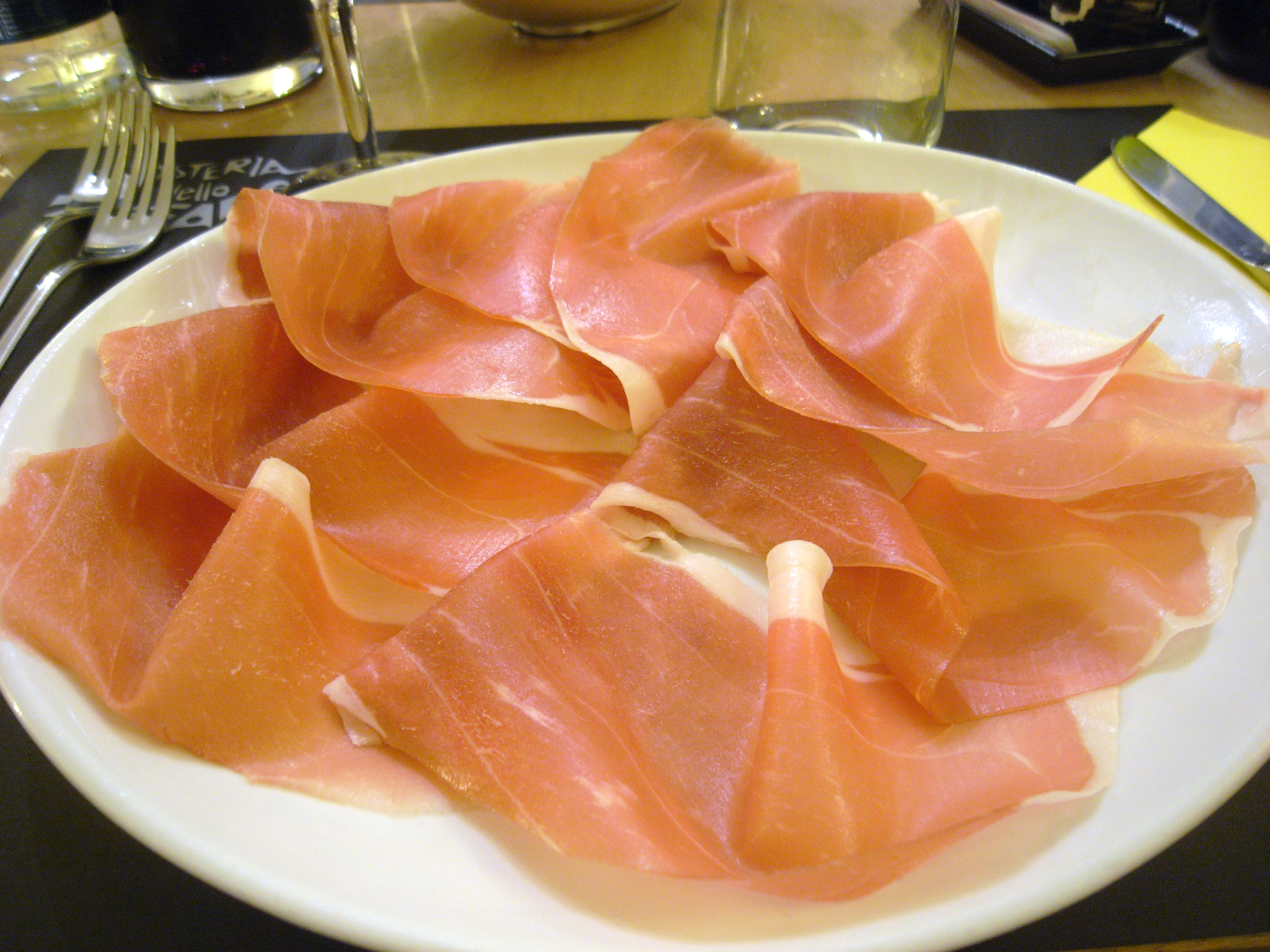|
Culatello Di Zibello
Culatello di Zibello is a cured meat with a Protected Designation of Origin (PDO) in the EU and UK (EC regulation n°1263/96) typical of the province of Parma. Listed among the Slow Food Presidia of Emilia-Romagna, Culatello, mentioned for the first time in a document dating back to 1735, is produced from the leg of pork, which is then stuffed into the pig's bladder. Production The Consortium of Culatello di Zibello has established that the processing of Culatello di Zibello can only take place in a specific and circumscribed area and exclusively in the period between October and February, when the Bassa is enveloped in fog and cold. It is in that period that the part of meat obtained from the thigh of adult pigs, bred according to traditional methods, is dehided, degreased, boned, separated from the Fiocchetto and trimmed by hand, so as to give it its characteristic "pear" shape. The culatello and fiocchetto trimmings are then used in the preparation of strolghino. These oper ... [...More Info...] [...Related Items...] OR: [Wikipedia] [Google] [Baidu] |
Curing (food Preservation)
Curing is any of various food preservation and flavoring processes of foods such as meat, fish and vegetables, by the addition of salt, with the aim of drawing moisture out of the food by the process of osmosis. Because curing increases the solute concentration in the food and hence decreases its water potential, the food becomes inhospitable for the microbe growth that causes food spoilage. Curing can be traced back to antiquity, and was the primary method of preserving meat and fish until the late 19th century. Dehydration was the earliest form of food curing. Many curing processes also involve smoking, spicing, cooking, or the addition of combinations of sugar, nitrate, and nitrite."Historical Origins of Food Preservation." [...More Info...] [...Related Items...] OR: [Wikipedia] [Google] [Baidu] |
Salame Di Felino
''Salame Felino'' is a variety of Italian cuisine, Italian ''salame'' historically produced in the municipality of Felino (hence the name) and in some neighboring municipalities, such as Sala Baganza and Langhirano, all in the province of Parma. Having obtained the European certification of "Protected Geographical Indication", this salami is protected from counterfeiting. Preparation ''Salame Felino'' is traditionally produced with pure pork meat. The mixture is made up of pork called "bench mince" (shoulder of the animal), roughly made up of 70% lean and 30% selected fat parts. The grinding takes place with medium dies, obtaining a medium-coarse-grained mixture that is added with salt, whole-grain pepper. Small amounts of potassium nitrate are usually added and sometimes ascorbates (antioxidants and acidity regulators) and sugars as well. After grinding, crushed garlic and pepper are also added and dissolved in dry white wine, then the mixture is stuffed into natural pork casing ... [...More Info...] [...Related Items...] OR: [Wikipedia] [Google] [Baidu] |
Cuisine Of Emilia-Romagna
A cuisine is a style of cooking characterized by distinctive ingredients, techniques and dishes, and usually associated with a specific culture or geographic region. Regional food preparation techniques, customs, and ingredients combine to enable dishes unique to a region. A cuisine is partly determined by ingredients that are available locally or through trade. Regional ingredients are developed and commonly contribute to a regional or national cuisine, such as Japanese rice in Japanese cuisine or New Mexico chile in New Mexican cuisine. Likewise, national dishes have variations, such as gyros in Greek cuisine and hamburger in American cuisine. Religious food laws can also exercise an influence on cuisine, such as Hinduism in Indian cuisine, Sikhism in Punjabi cuisine, Buddhism in East Asian cuisine, Christianity in European cuisine, Islam in Middle Eastern cuisine, and Judaism in Jewish and Israeli cuisine. Etymology Cuisine is borrowed from the French meaning cook ... [...More Info...] [...Related Items...] OR: [Wikipedia] [Google] [Baidu] |
Italian Cuisine
Italian cuisine (, ) is a Mediterranean cuisine#CITEREFDavid1988, David 1988, Introduction, pp.101–103 consisting of the ingredients, recipes and List of cooking techniques, cooking techniques developed across the Italian Peninsula and later spread around the world together with waves of Italian diaspora. Some of these foods were imported from other cultures. Significant changes Columbian Exchange, occurred with the colonization of the Americas and the introduction of potatoes, tomatoes, capsicums, maize and sugar beet — the latter introduced in quantity in the 18th century. It is one of the best-known and most appreciated Gastronomy, gastronomies worldwide. Italian cuisine includes deeply rooted traditions common to the whole country, as well as all the Regional cuisine, regional gastronomies, different from each other, especially between Northern Italy, the north, Central Italy, the centre and Southern Italy, the south of Italy, which are in continuous exchange. Many di ... [...More Info...] [...Related Items...] OR: [Wikipedia] [Google] [Baidu] |
Salumi
Salumi (singular salume) are Italian meat products typical of an antipasto, predominantly made from pork and cured. Salumi also include bresaola, which is made from beef, and some cooked products, such as mortadella and prosciutto cotto. The word ''salumi'', "salted meat," derives from Latin ''sal'', "salt".OED sv. salumeria, ''n.'' Examples of salumi include: * (Italian: ''Prosciutto crudo'') ** ** ** ** ** / * * * * * * * * * * * * ** ** , traditionally produced in Felino and other cities in the Parma Parma (; egl, Pärma, ) is a city in the northern Italian region of Emilia-Romagna known for its architecture, Giuseppe Verdi, music, art, prosciutto (ham), Parmigiano-Reggiano, cheese and surrounding countryside. With a population of 198,292 ... province, qualifies for Prodotto agroalimentare tradizionale ** ** ** See also * * * * References External links Lunch meat Italian cuisine Pork Dried meat Sausages {{it ... [...More Info...] [...Related Items...] OR: [Wikipedia] [Google] [Baidu] |
Wiktionary Small
Wiktionary ( , , rhyming with "dictionary") is a multilingual, web-based project to create a free content dictionary of terms (including words, phrases, proverbs, linguistic reconstructions, etc.) in all natural languages and in a number of artificial languages. These entries may contain definitions, images for illustration, pronunciations, etymologies, inflections, usage examples, quotations, related terms, and translations of terms into other languages, among other features. It is collaboratively edited via a wiki. Its name is a portmanteau of the words ''wiki'' and ''dictionary''. It is available in languages and in Simple English. Like its sister project Wikipedia, Wiktionary is run by the Wikimedia Foundation, and is written collaboratively by volunteers, dubbed "Wiktionarians". Its wiki software, MediaWiki, allows almost anyone with access to the website to create and edit entries. Because Wiktionary is not limited by print space considerations, most of Wiktionary's ... [...More Info...] [...Related Items...] OR: [Wikipedia] [Google] [Baidu] |
Cuisine Of Emilia
A cuisine is a style of cooking characterized by distinctive ingredients, techniques and dishes, and usually associated with a specific culture or geographic region. Regional food preparation techniques, customs, and ingredients combine to enable dishes unique to a region. A cuisine is partly determined by ingredients that are available locally or through trade. Regional ingredients are developed and commonly contribute to a regional or national cuisine, such as Japanese rice in Japanese cuisine or New Mexico chile in New Mexican cuisine. Likewise, national dishes have variations, such as gyros in Greek cuisine and hamburger in American cuisine. Religious food laws can also exercise an influence on cuisine, such as Hinduism in Indian cuisine, Sikhism in Punjabi cuisine, Buddhism in East Asian cuisine, Christianity in European cuisine, Islam in Middle Eastern cuisine, and Judaism in Jewish and Israeli cuisine. Etymology Cuisine is borrowed from the French meaning cooking, c ... [...More Info...] [...Related Items...] OR: [Wikipedia] [Google] [Baidu] |
Strolghino
Strolghino is a salami in Italian cuisine that is prepared from pork. It is thin, with an average weight of 300 grams, and may be prepared from the "lean leg meat" of the domestic pig. Leftover cuts of meat from the preparation of ''culatello'' prosciutto are typically used. It may be prepared from parts of the pig that are not used in ham. Strolghino may only be available for only a few months in some areas. It may have a relatively short curing time of 15–20 days, which results in a very tender product resembling "fresh, raw sausage meat". In the Italian cities of Cremona and Parma, it may be referred to as "strolghino salami filzetta", and its preparation in these areas may include curing for three months. Up to around 2010, its availability in Italy was rather rare, but after this time its availability had slightly increased. As of 2012, strolghino was not protected or regulated in Italy (e.g. with a protected designation of origin or protected geographical indication). ... [...More Info...] [...Related Items...] OR: [Wikipedia] [Google] [Baidu] |
Parma Ham
''Prosciutto crudo'', in English often shortened to prosciutto ( , ), is Italian uncooked, unsmoked, and dry-cured ham. ''Prosciutto crudo'' is usually served thinly sliced. Several regions in Italy have their own variations of ''prosciutto crudo'', each with degrees of protected status, but the most prized are Prosciutto di Parma DOP from Emilia-Romagna and Prosciutto di San Daniele DOP from Friuli Venezia Giulia. Unlike Speck (Speck Alto Adige PGI) from the South Tyrol region, prosciutto is not smoked. In Italian, ''prosciutto'' means any kind of ham, either dry-cured (''prosciutto crudo'' or simply ''crudo'') or cooked (''prosciutto cotto''), but in English-speaking countries, it usually means either Italian ''prosciutto crudo'' or similar hams made elsewhere. However, the word "prosciutto" itself is not protected; cooked ham may legally be, and in practice is, sold as ''prosciutto'' (usually as ''prosciutto cotto'', and from Italy or made in the Italian style) in English-spe ... [...More Info...] [...Related Items...] OR: [Wikipedia] [Google] [Baidu] |
Protected Designation Of Origin
The protected designation of origin (PDO) is a type of geographical indication of the European Union and the United Kingdom aimed at preserving the designations of origin of food-related products. The designation was created in 1992 and its main purpose is to designate products that have been produced, processed and developed in a specific geographical area, using the recognized know-how of local producers and ingredients from the region concerned. The list below also shows other geographical indications. Features The characteristics of the products protected are essentially linked to their terroir. The European or UK PDO logo, of which the use is compulsory, documents this link. European Regulation 510/2006 of 20 March 2006 acknowledges a priority to establish a community protection system that ensures equal conditions of competition between producers. This European Regulation is intended to guarantee the reputation of regional products, adapt existing national protections t ... [...More Info...] [...Related Items...] OR: [Wikipedia] [Google] [Baidu] |
Strolghino
Strolghino is a salami in Italian cuisine that is prepared from pork. It is thin, with an average weight of 300 grams, and may be prepared from the "lean leg meat" of the domestic pig. Leftover cuts of meat from the preparation of ''culatello'' prosciutto are typically used. It may be prepared from parts of the pig that are not used in ham. Strolghino may only be available for only a few months in some areas. It may have a relatively short curing time of 15–20 days, which results in a very tender product resembling "fresh, raw sausage meat". In the Italian cities of Cremona and Parma, it may be referred to as "strolghino salami filzetta", and its preparation in these areas may include curing for three months. Up to around 2010, its availability in Italy was rather rare, but after this time its availability had slightly increased. As of 2012, strolghino was not protected or regulated in Italy (e.g. with a protected designation of origin or protected geographical indication). ... [...More Info...] [...Related Items...] OR: [Wikipedia] [Google] [Baidu] |






